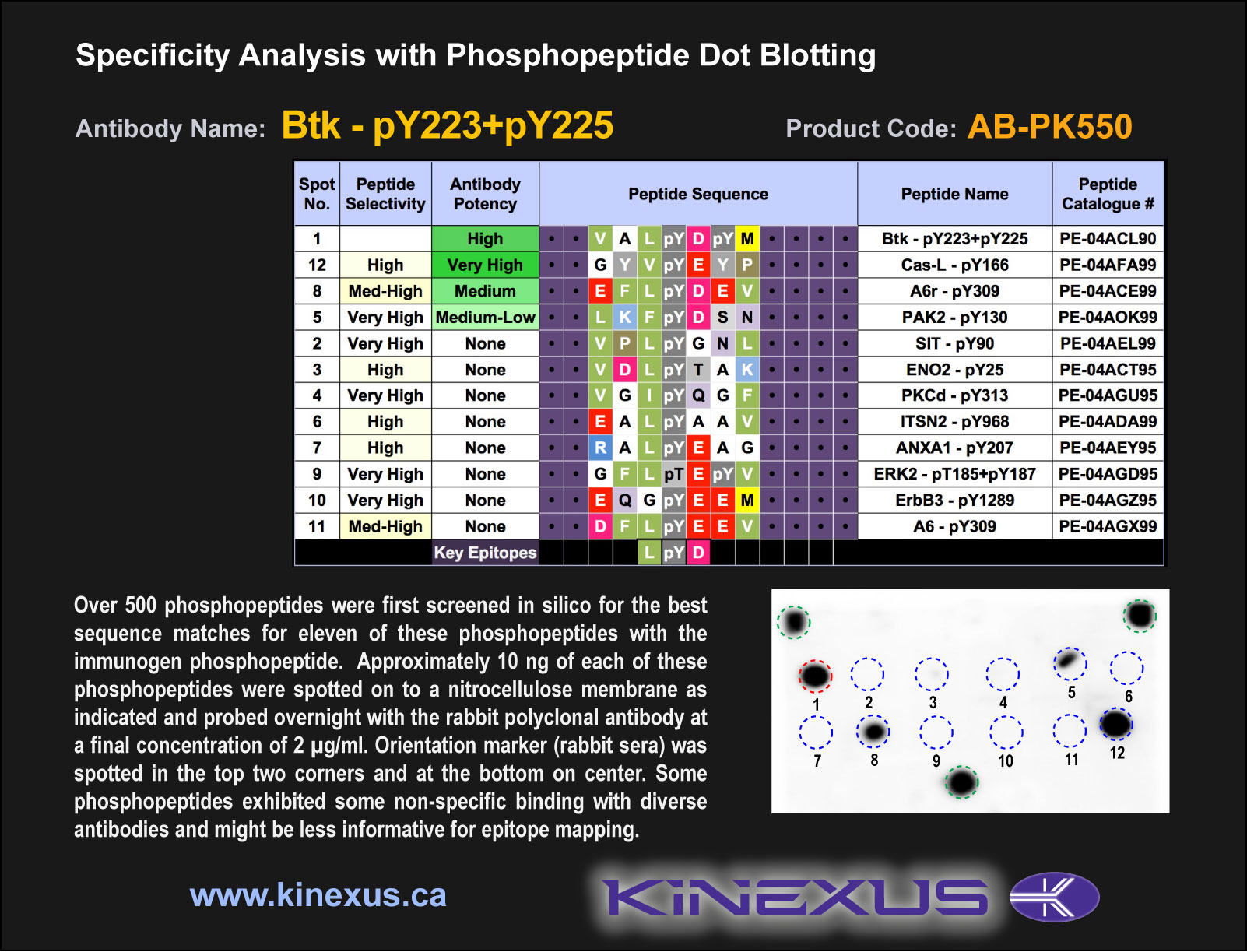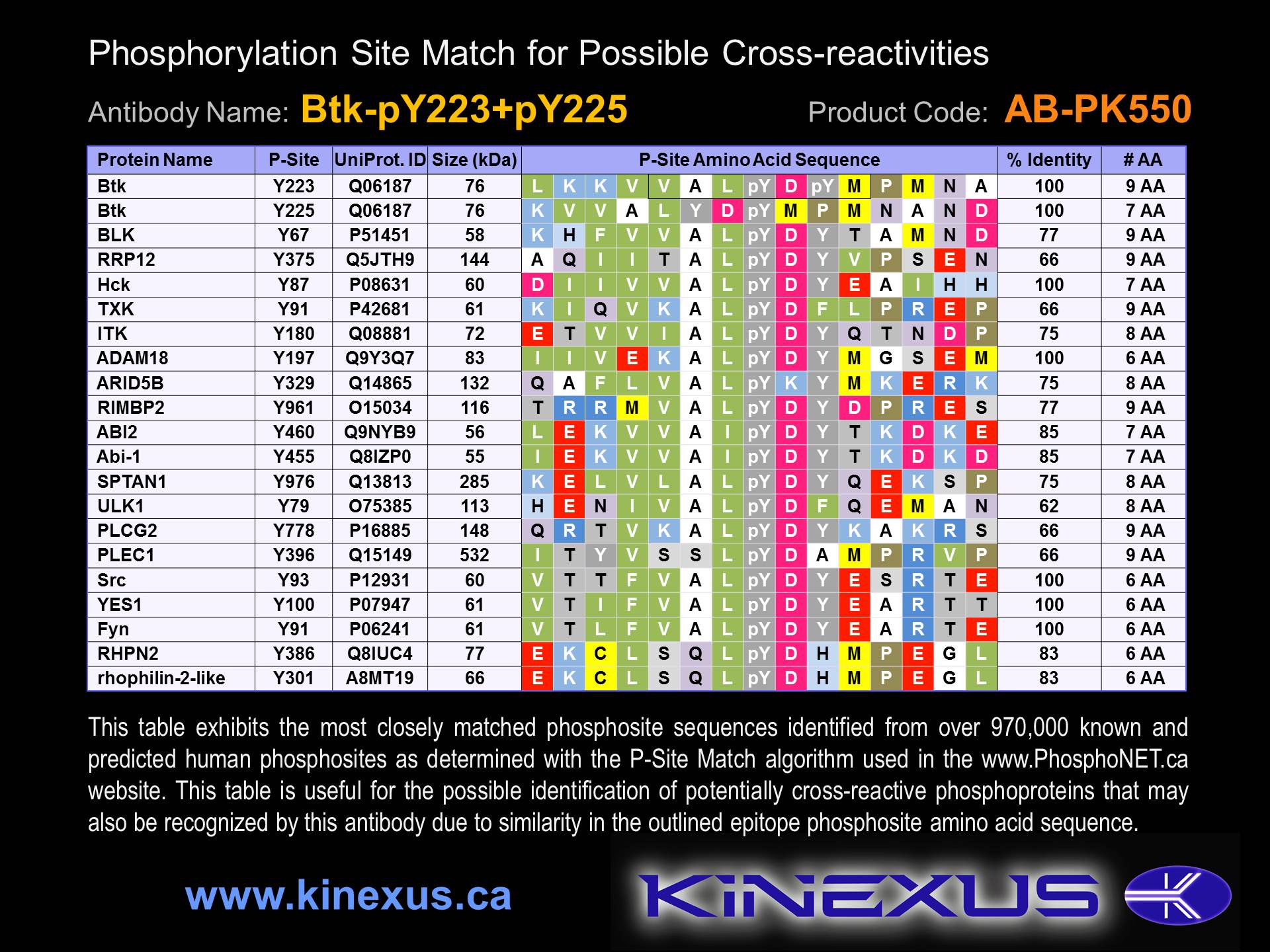Product Name: Btk-pY223+pY225
Product Number: AB-PK550
| Size: | 25 µg | Price: | 89.00 | |
| $US |
Target Full Name: Bruton's agammaglobulinemia tyrosine kinase
Target Alias: Agammaglobulinaemia tyrosine kinase; AGMX1; ATK; B cell progenitor kinase; BPK; Bruton agammaglobulinemia tyrosine kinase; EMB; IMD1; XLA; AT; ATK; BPK; XLA; IMD1; AGMX1; PSCTK1; MGC126261; MGC126262; RP1-164F3_2; XLA; ENSG00000010671
Product Type Specific: Protein kinase phosphosite-specific antibody
Antibody Code: PK550
Antibody Target Type: Phosphosite-specific
Antibody Phosphosite: Y223+Y225
Protein UniProt: Q06187
Protein SigNET: Q06187
Antibody Type: Polyclonal
Target Alias: Agammaglobulinaemia tyrosine kinase; AGMX1; ATK; B cell progenitor kinase; BPK; Bruton agammaglobulinemia tyrosine kinase; EMB; IMD1; XLA; AT; ATK; BPK; XLA; IMD1; AGMX1; PSCTK1; MGC126261; MGC126262; RP1-164F3_2; XLA; ENSG00000010671
Product Type Specific: Protein kinase phosphosite-specific antibody
Antibody Code: PK550
Antibody Target Type: Phosphosite-specific
Antibody Phosphosite: Y223+Y225
Protein UniProt: Q06187
Protein SigNET: Q06187
Antibody Type: Polyclonal
Antibody Host Species: Rabbit
Antibody Immunogen Source: Human Btk sequence peptide Cat. No.: PE-04ACL90
Antibody Immunogen Sequence: VAL(pY)D(pY)M(bA)C
Antibody Immunogen Description: Corresponds to amino acid residues V220 to M226; In the SH3_1 domain
Antibody Immunogen Source: Human Btk sequence peptide Cat. No.: PE-04ACL90
Antibody Immunogen Sequence: VAL(pY)D(pY)M(bA)C
Antibody Immunogen Description: Corresponds to amino acid residues V220 to M226; In the SH3_1 domain
Production Method: The immunizing peptide was produced by solid phase synthesis on a multipep peptide synthesizer and purified by reverse-phase hplc chromatography. Purity was assessed by analytical hplc and the amino acid sequence confirmed by mass spectrometry analysis. This peptide was coupled to KLH prior to immunization into rabbits. New Zealand White rabbits were subcutaneously injected with KLH-coupled immunizing peptide every 4 weeks for 4 months. The sera from these animals was applied onto an agarose column to which the immunogen peptide was thio-linked. Antibody was eluted from the column with 0.1 M glycine, pH 2.5. Subsequently, the antibody solution was neutralized to pH 7.0 with saturated Tris.This antibody was also subject to negative purification over phosphotyrosine-agarose.
Antibody Modification: Unconjugated. Contact KInexus if you are interest in having the antibody biotinylated or coupled with fluorescent dyes.
Antibody Modification: Unconjugated. Contact KInexus if you are interest in having the antibody biotinylated or coupled with fluorescent dyes.
Antibody Concentration: 0.3 mg/ml
Storage Buffer: Phosphate buffered saline pH 7.4, 0.05% Thimerasol
Storage Conditions: For long term storage, keep frozen at -40°C or lower. Stock solution can be kept at +4°C for more than 3 months. Avoid repeated freeze-thaw cycles.
Product Use: Western blotting | Antibody microarray
Antibody Dilution Recommended: 2 µg/ml for immunoblotting
Antibody Potency: Very weak immunoreactivity of a target-sized protein by Western blotting in Jurkat and HEK-293 cells. Strong immunoreactivity with immunogen peptide on dot blots.
Antibody Species Reactivity: Human
Storage Buffer: Phosphate buffered saline pH 7.4, 0.05% Thimerasol
Storage Conditions: For long term storage, keep frozen at -40°C or lower. Stock solution can be kept at +4°C for more than 3 months. Avoid repeated freeze-thaw cycles.
Product Use: Western blotting | Antibody microarray
Antibody Dilution Recommended: 2 µg/ml for immunoblotting
Antibody Potency: Very weak immunoreactivity of a target-sized protein by Western blotting in Jurkat and HEK-293 cells. Strong immunoreactivity with immunogen peptide on dot blots.
Antibody Species Reactivity: Human
Antibody Positive Control: The observed molecular mass of the processed target protein on SDS-PAGE gels is reported to be around 75-80 kDa.
Antibody Specificity: Very high
Antibody Cross Reactivity: No cross-reactive proteins evident in Jurkat cells, HEK-293 cells and in sea star oocytes.
Related Product 1: Btk-pY223+pY225 blocking peptide
Related Product 2: Btk-pY551 phosphosite-specific antibody (Cat. No.: AB-PK551)
Antibody Specificity: Very high
Antibody Cross Reactivity: No cross-reactive proteins evident in Jurkat cells, HEK-293 cells and in sea star oocytes.
Related Product 1: Btk-pY223+pY225 blocking peptide
Related Product 2: Btk-pY551 phosphosite-specific antibody (Cat. No.: AB-PK551)
Scientific Background: BTK is a protein-tyrosine kinase of the TK group and Tec family. It is a non-receptor kinase that is essential for B-cell development, differentiation, and function. In addition, BTK phosphotransferase activity is required for radiation induced apoptosis in immune cells. After B-cell receptor (BCR) activation, BTK translocates to the plasma membrane and is phosphorylated on Y551 catalyzed by the Lyn and Syk proteins, followed by autophosphorylation at Y223. Phosphorylation at Y223 and Y551 increases phosphotransferase activity.Phosphorylation at S180 causes translocation back to the cytoplasm, leading to downstream phosphorylation of PLCG2 at several conserved phosphosites and the stimulation of downstream calcium dependent signalling mechanisms. BTK is thought to act as a scaffold to bring together various intracellular signalling proteins to function in cytokine receptor signalling pathways. In immune cells, BTK is a vital component of the toll-like receptor (TLR) pathway, which is the primary system used to identify pathogens and activate host defence systems.
Figure 1. Epitope mapping of Btk-pY223+pY225 antibody with similar phosphopeptides on dot blots.
Figure 2. Identification of phosphosites related to Btk-pY223+pY225.
© Kinexus Bioinformatics Corporation 2017



